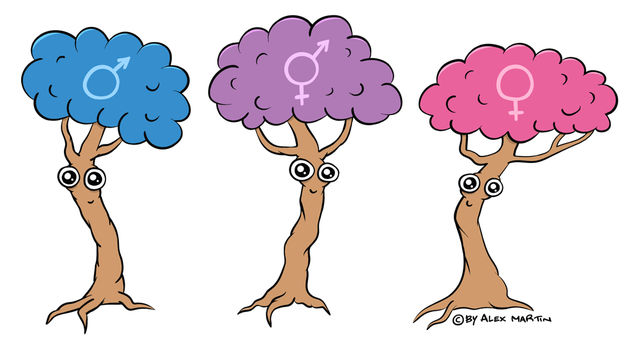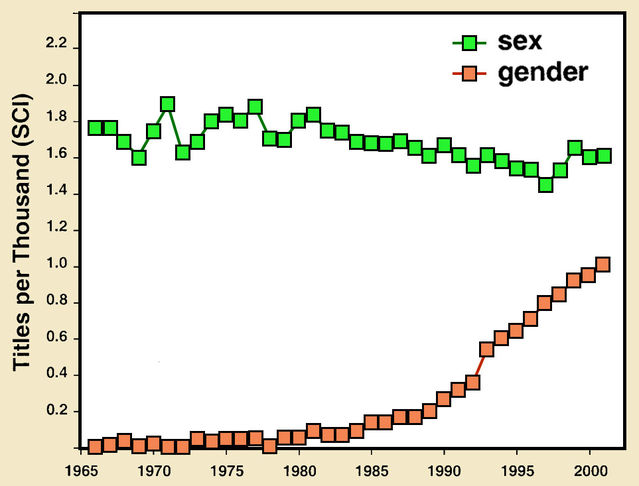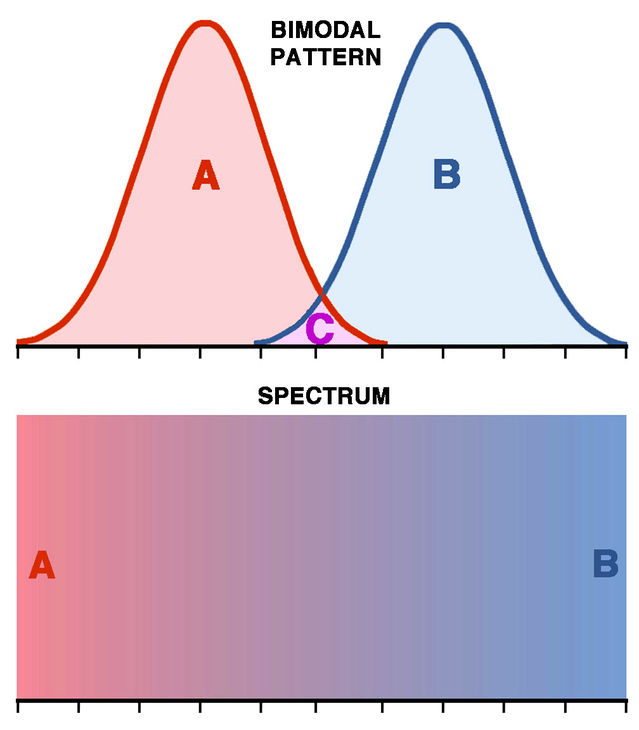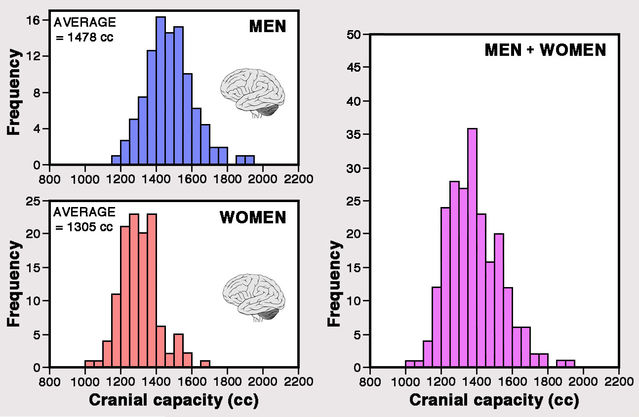Sex
No Substitute for Sex
“Gender” and “sex” have very different meanings.
Posted August 20, 2019 Reviewed by Matt Huston

Background research for my previous blog post once again triggered the choice of the next topic. This time, I was goaded (not inspired) by yet another example of treating “sex” and “gender” as interchangeable and preferring gender, because it is supposedly politically correct.
An otherwise pleasurable reading of Scanning the Pharaohs by Zahi Hawass and Sahar Saleem was abruptly blighted by a section entitled “determination of gender,” beginning: “The gender of the mummy can be determined from the morphology of the external genitalia (if preserved) as well as from the skeleton.” Incongruously, the final sentence mentions “sex” three times: “However, sex-related differences between skeletons have such a large overlap between the sexes that in the middle of the range no sexual distinction can be made.” References to sex pop up sporadically throughout the book, yet the index lists 27 entries for gender but none for sex. Why? It's possible the editors intended to delete any mention of sex, but didn't manage to do so.
What Do "Sex" and "Gender" Mean?
Prior to 2010, the program Gender, Women & Health, under the aegis of the World Health Organization, posted the following concise statement:
Sometimes it is hard to understand exactly what is meant by the term ‘gender,’ and how it differs from the closely related term ‘sex.’ ‘Sex’ refers to the biological and physiological characteristics that define men and women. ‘Gender’ refers to the socially constructed roles, behaviours, activities, and attributes that a given society considers appropriate for men and women.”
Women’s menstruation and men’s testicles were cited as examples of sex characteristics, while women earning significantly less for similar work and men doing less housework exemplified gender characteristics. (But let it be noted that many sex characteristics typically associated with men and women can be present or absent in transgender or intersex people.)
Many see gender, thus defined, as uniquely human. But some non-human primates may have rudimentary gender roles. A thoughtful Sapiens post by Jay Schwartz cogently argues that chimpanzees might have some sense of gender identity, showing natural variation in sex-correlated features such as aggression and status-seeking behavior. Unaccountably, many authors tolerate continued use of “sex” for animals, while others feel compelled to extend political correctness outside humans.
The title of a 1988 paper on stumptail macaques by Kees Nieuwenhuijsen and colleagues explicitly mentioned “gender-related behaviors”. And the trend oozed out to engulf other animals, as exemplified by Judy Wilson’s post “Identifying frog genders” in Pets on Mom.me. Surprisingly, even some botanists use gender to refer to unusual reproductive features of certain plants. However, botanists and zoologists occasionally use gender in a specific sense to refer to complexities in male/female distinctions, not as a substitute for sex.

A 2004 paper by David Haig, surveying over 30 million academic article titles from 1945 to 2001, identified an “inexorable rise of gender and the decline of sex.” Gender was rarely mentioned before 1980, but by 2001 titles in the social sciences, arts, and humanities used it far more often than sex. Even in the natural sciences, mentions of gender climbed, creeping steadily closer to uses of sex.
Should “Gender” Replace “Sex”?
According to some chatter on the internet, it is perfectly OK if “gender” simply absorbs or replaces “sex.” This, it is claimed, is just how language evolves. Merely mentioning sex is deemed likely to offend members of the LGBTQIA (lesbian, gay, bisexual, transgender, queer, intersex, asexual) community, so it deserves to be purged.
But the truth is that—properly used—sex and gender have very distinct meanings. Misuse either way is confusing and can detract from legitimate aspirations of the LGBTQIA community, whose primary need is gaining recognition and eliminating discrimination rather than linguistic sanitization. If we allow gender to usurp sex, we will need to find some other word to distinguish biological from cultural aspects.
Here, as elsewhere, historical context helps. By general consent, the word “sex” stems from the Latin sexus, but the initial source is uncertain. An oft-mentioned possibility is derivation from the Latin secare (to divide). By contrast, the word “gender,” stemming from the Latin genus, simply means “kind.” It was, in fact, long used primarily with respect to language. For nouns, European languages (ironically excluding English) typically have at least two genders—masculine and feminine.

Degrees of Distinction
Some biological features show virtually complete separation between sexes. By convention, across the animal kingdom, individuals producing large sex cells (eggs) are “females,” whereas producers of tiny sex cells (sperms) are “males.” In the human body, eggs count among the largest cells and sperms among the smallest. External genitals of mammals are also generally distinct, with the penis of males typically longer than the clitoris of females. However, many other features vary widely. For each sex, individual dimensions commonly fit a classic bell curve (normal distribution) with the average value at its peak, but male and female curves often partially overlap, yielding a twin-peak bimodal distribution. Differences between the peak values are commonly statistically significant, but in the overlap zone males and females intermingle. Here, the label intersex may be used, particularly if unusual features of sex chromosomes are involved. However, this oversimplifies a complex set of conditions.
When confronted with human skeletons from excavations, archaeologists need to identify age at death and sex. Hip anatomy indicates sex most reliably because pelvic canal dimensions are crucial for birth. Several hip features show a bimodal distribution with limited overlap, permitting around 95% correct male/female separation.
Combined analysis yields even better resolution. In a 1990 paper, Nicholas Milne reported analysis of 8 hip bone dimensions taken together. Five experienced anatomists visually assessed the likely sex of hip bones from 62 skeletons and Milne compared their ratings with his quantitative findings. The match was almost perfect; only two hip bones assessed as female would have been mis-classified as male from their dimensions.
![Source: PCA plot adapted from a figure in Milne (1990). Insets showing male and female hip bones derived from Henry Vandyke Carter [Public domain] via Wikimedia Commons. Source: PCA plot adapted from a figure in Milne (1990). Insets showing male and female hip bones derived from Henry Vandyke Carter [Public domain] via Wikimedia Commons.](https://cdn.psychologytoday.com/sites/default/files/styles/image-article_inline_full_caption/public/field_blog_entry_images/2019-08/pelvis_discrim_milne_90_combo.jpg?itok=zlqz2mPi)
When sex is inferred from anatomical features of a human skeleton, mentioning gender is usually inappropriate. Occasionally, however, other information conflicts with inferred biological sex. Take, for instance, a case where a skeleton identified as female is found with armour and weapons as grave goods. A reasonable interpretation is that an individual of female sex was a warrior, even if being a warrior was a traditional male gender role in her population. This neatly illustrates why we need to distinguish sex from gender.

With other features, male/female distinctions are far less apparent, and overlap is so extensive that the overall distribution does not have twin peaks. Consider the oft-discussed difference in brain size between men and women, frequently assessed from cranial capacity. Although average brain size is significantly smaller in women than men—just over 10% less—values overlap to such a degree that sex cannot be reliably inferred from cranial capacity alone. Moreover, the brain size difference between men and women predominantly reflects differences in body size.
Rejections of rigid distinctions between males and females often refer to a binary division. However, that term refers to a system with only two distinct states (0 or 1), widely familiar because it is used in computer code. A binary system has no overlap, so it is quite unlike the bimodal pattern familiar to biologists. That pattern, in turn, is totally different from a spectrum, which has a gradual transition from one extreme to another with no obvious boundary. The classic example is the optical spectrum. It has been argued that human gender is a spectrum, but biological sex is definitely not a smooth continuum.
Overlap between males and females in a bimodal distribution is crucially important when it comes to value judgments, which have no basis in biology. One claim often made regarding the LGBTQIA community, for instance, is that certain sexual preferences are “unnatural.” Yet incomplete separation between male and female conditions is an outcome of natural variation! Variation provides the raw material for evolution through natural selection, the motor of diversification of life on our planet.
"Sex" and "Gender" Should Be Used Appropriately
If it is accepted that sex is biological whereas gender is cultural, radical change is needed to reverse the current trend towards treating gender and sex as synonymous. Perhaps the prize for the most blatant misuse should go to the documentary film The Great Sperm Race, whose narrator Richard Armitage blithely referred to “gender chromosomes.” It is time to stop assigning “gender” to frogs, fossils or fetuses. Culture plays no part in any of these contexts, and the biologically appropriate term is “sex.”
Any reader who—despite all of the above points—still believes that sex and gender are interchangeable should reflect on this: “One of life’s greatest pleasures is having gender with a partner.”
[P.S. I am very grateful to my new Facebook friend Claudia Astorino—an active advocate for intersex people—for providing extremely useful feedback on this blog piece at short notice.]
References
Astorino, C.M. (2019) Beyond dimorphism: Sexual polymorphism and research bias in biological anthropology. American Anthropologist 121:489-490
Blackless, M., Charuvastra, C., Derryck, A., Fausto-Sterling, A., Lauzanne, K. & Lee, E. (2000) How sexually dimorphic are we? Review and synthesis. American Journal of Human Biology 12:151-166.
Borges, R. (1998) Gender in plants. Resonance 3:30-39.
Channel 4 TV & Wellcome Trust (2009) The Great Sperm Race (Human Anatomy Documentary). Narrated by Richard Armitage.
https://trakt.tv/shows/channel-4-uk-documentaries/seasons/2009/episodes…
Haig, D. (2004) The inexorable rise of gender and the decline of sex: Social change in academic titles, 1945–2001. Archives of Sexual Behavior 33:87-96.
Hawass, Z.A. & Saleem, S.N. (2018) Scanning the Pharaohs: CT Imaging of the New Kingdom Royal Mummies. Cairo, Egypt: American University in Cairo Press.
Lloyd, D.G. & Bawa, K.S. (1984) Modifications of the gender of seed plants in varying conditions. Evolutionary Biology 17:255-338.
Luraghi, S. (2011) The origin of the Proto-Indo-European gender system: Typological considerations. Folia Linguistica 45:435-463.
Milne, N. (1990) Sexing of human hip bones. Journal of Anatomy 172:221-226.
Nieuwenhuijsen, K., Slob, A.K. & Van der Werff Ten Bosch, J.J. (1988) Gender-related behaviors in group-living stumptail macaques. Psychobiology 16:357-371.
Schwartz, J. (2018) Is gender unique to humans? Evidence from our closest evolutionary relatives suggests that we might not be the only animals with a sense of gender identity. Blog post in Sapiens
https://www.sapiens.org/culture/gender-identity-nonhuman-animals/
Spielman, M., Vinkenoog, R., Dickinson, H.G. & Scott, R.J. (2001) The epigenetic basis of gender in flowering plants and mammals. Trends in Genetics 17:705-711.
YouTube video produced by PBS Digital Studios (2018) The Origin of Gender. Written and hosted by Danielle Bainbridge.
http://gourl.gr/b7on
YouTube video interview with Claudia Astorino produced by PBS Digital Studios (2015) Growing Up Intersex. Hosted by Kristin Russo.
https://www.youtube.com/watch?v=agdTj9f3F0o




